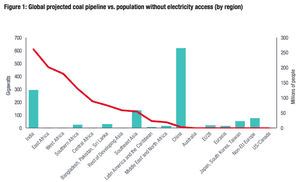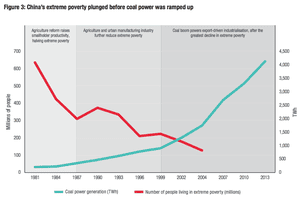Climate denial often centers around myths about the importance of coal in alleviating poverty
The coal-fired Castle Gate Power Plant is pictured outside Helper, Utah. Photograph: George Frey/Reuters Dana Nuccitelli
A dozen international poverty and development organizations published a report last week on the impact of building new coal power plants in countries where a large percentage of the population lacks access to electricity. The report’s conclusions are strikingly counter-intuitive: on the whole, building coal power plants does little to help the poor, and often it can actually make them poorer.
Delivering electricity to those in energy poverty is certainly important. For example, household air pollution killed 4.3 million people globally in 2012; many of those lives could be saved and health improved with the use of electric stoves to replace burning wood or charcoal. However, the question remains whether coal is the best way to deliver that electricity.
More coal doesn’t help people living close to the grid
The report notes that approximately 15% of people in energy poverty live close to existing electric grids, but there are a variety of barriers blocking their connection. For example, the poor consume relatively little electricity, so the costs of connecting them may exceed the resulting profits. The power lines used to connect them also result in high energy losses and power system instability. The poor also have little political influence in many developing countries. As the report concludes:
This means that for energy-poor families living close to the grid, building new power generation capacity – coalfired or otherwise – will not help them get connected. Instead, access will require financing the upfront costs of new connections, and rationalising tariffs to reflect the true costs of supplying power.
More coal also doesn’t help people in rural areas
Approximately 84% of energy-poor households live in rural areas further away from the grid. For this group, decentralized stand-alone and mini-grid solutions are much quicker than waiting to build a new centralized power plant and distribution lines. A single power plant can take a decade between planning and ultimate completion, while distributed wind turbines or solar panels can be deployed much more rapidly, as Elon Musk explained in ‘Before the Flood’:
In fact, most planned coal development isn’t aimed at delivering electricity to the poor. It’s mostly targeted toward industrialized areas in China, which already have high levels of access to electricity. In India, many areas with the densest concentration of coal plants also have the lowest rates of electricity access. 
New coal plants aren’t built for the poor because it’s not profitable.
China dramatically reduced poverty, but coal played only a small roleThere’s a common misconception that China’s coal power expansion lifted much of its population out of poverty. For example, according to Bjorn Lomborg:
Over the last 30 years, China moved an estimated 680 million people out of poverty by giving them access to modern energy, mostly powered by coal.
However, as this new report notes, about two-thirds of China’s reduction in extreme poverty occurred in the 1980s, before its dramatic expansion of coal power starting in the 1990s.

More importantly, China enacted agricultural reform, which helped the profitability of small farms. China’s hard push towards industrialization did rely on coal power, but it only happened after the agricultural reforms had lifted most of its population out of extreme poverty.
Burning coal causes air, water, and carbon pollution
China’s air pollution problems are an example of the consequences of relying too heavily on burning coal for generating electricity. The report notes that sickness and death caused by air pollution currently costs China an estimated 9.7% to 13.2% of its GDP annually. It currently causes some 670,000 premature deaths a year in China and 100,000 in India. Coal also requires substantial amounts of freshwater for operation:
The coal industry withdraws, consumes and pollutes substantial quantities of freshwater, often competing for limited water resources with other sectors, such as smallholder agriculture, that are crucial for poverty reduction. Roughly 44% of existing and planned coal plants are located in areas with high to extremely high water stress. A quarter are located in ‘red-listed’ areas, where surface and groundwater resources are at risk of drying up because water is being withdrawn faster than it can be replenished … Coal plants’ direct competition with poor farmers for scarce water resources has already led to political tensions and social unrest.
And of course the more coal we burn, the more global warming will result. Poorer countries tend to be the most vulnerable to the impacts of climate change. As the report notes:
By 2050, climate change impacts could draw an estimated 720 million people into extreme poverty (Granoff et al., 2015). This is about the same number lifted out of extreme poverty in the last two decades and would thus cancel out much of the progress made in poverty eradication to date … Coal expansion as currently planned is enough to push climate change to catastrophic levels. A changing climate already disproportionately hits the poorest people with least resources to enable them to adapt.
Wind and solar are already becoming cheaper than coal
Not only are wind and solar better for the poor in terms of ease of deployment, clean air, and slowing climate change, they’ve also become cost-competitive.
South Africa, for example, is the cheapest place in Africa to generate coal-fired power, yet electricity from its new 4.7 gigawatt Medupi advanced coal plant will cost … 17% more than the electricity generated from South Africa’s 2 gigawatt of new onshore wind power. In India, the minister responsible for power development recently stated: ‘I think a new coal plant would give you costlier power than a solar plant’ (Climate Home, 2016). The statement is supported by the extremely low bid prices for recent solar procurements in India (Kenning, 2015). Renewable energy investment in the emerging world now outpaces that in developed countries (McGrath, 2016).
Renewable energy also has low operating cost and zero fuel cost, while fossil fuel costs are variable and susceptible to price spikes. And renewable energy creates more (and safer) jobs than coal.
Coal companies and their allies often argue that we need to burn their products to lift the poor out of poverty. For example, Matt Ridley has claimed:
those who advocate no support for coal are effectively saying that the adoption of renewable energy is more important than alleviating African poverty
In reality, there are better, faster, cleaner alternatives to help deliver electricity to the energy-poor. Those who argue to the contrary often do so to advance their own agendas.

